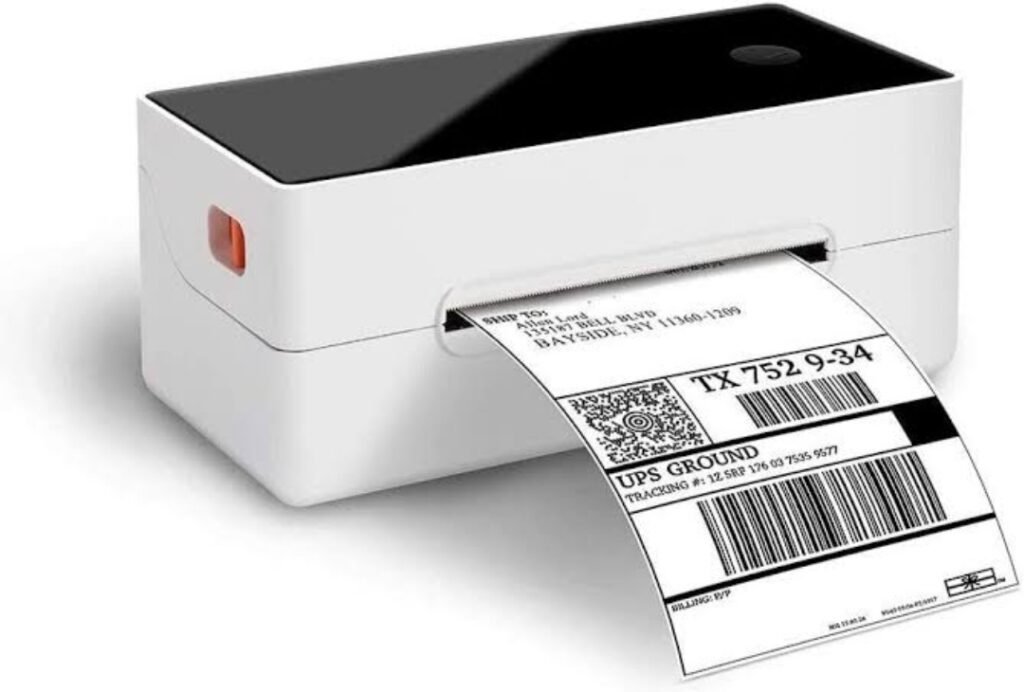Thermal printers are efficient and cost-effective for producing labels across various industries. However, when it comes to choosing a label for thermal printers, compatibility remains a question to achieve high-quality results and minimise maintenance costs.
This blog provides an in-depth guide on how to select compatible labels for a thermal sticker printer, considering printer types, materials, applications, and other key factors.
Understanding Thermal Printing Technology
1. Types of Thermal Printers:
There are two primary types of thermal printers: Direct Thermal and Thermal Transfer.
Direct Thermal Printing:
This process uses a thermal printhead to heat a heat-sensitive coating on the label, creating text or images. This eliminates the need for consumables such as ink, toner, or ribbons, making it a cost-effective and straightforward option.
Thermal Transfer Printing:
This process involves heating a ribbon that transfers ink onto the label material. Thermal transfer printing creates more durable labels that can resist environmental stressors such as light, moisture, and chemicals.
2. Printer Compatibility:
Each type of thermal sticker printer works best with specific label types. Direct thermal printers require heat-sensitive labels that are suitable for short-term use. On the other hand, Thermal Transfer printers can work with various materials, including synthetic labels, for long-term applications.
Matching Labels to Applications
1. Durability Requirements:
The application of a label dictates its durability requirements:
Short-Term Applications:
Direct thermal labels are ideal for short-term uses like shipping labels, retail tags, and receipts. They work well when longevity and environmental resistance are not primary concerns.
Long-Term Applications:
Thermal transfer labels are suitable for long-term or industrial needs, such as asset tracking, product labelling, and barcode labels. They resist environmental factors and can endure for extended periods.
2. Environmental Resistance:
Consider the environmental conditions labels for thermal printers will face:
Moisture and Water:
Synthetic labels made from polyester, polypropylene, or vinyl offer high resistance to moisture and water, making them ideal for outdoor or industrial settings.
Light and Heat:
Thermal transfer labels resist fading from light and heat better than direct thermal labels, making them a better choice for applications exposed to sunlight or temperature variations.
Materials and Their Compatibility
1. Paper Labels:
Versatility:
Paper labels are compatible with both direct thermal and thermal transfer printers, offering versatility for various applications.
Drawbacks:
Paper labels may not withstand environmental factors like moisture or chemicals, limiting their use to indoor or short-term needs.
2. Synthetic Labels:
Durability:
Synthetic labels, made from materials like polyester, polypropylene, or vinyl, are highly durable and resistant to environmental stressors.
Thermal Transfer Compatibility:
These labels work best with thermal transfer printers, which can create long-lasting prints on them.
Adhesive Options
1. Permanent Adhesives:
For Long-Term Use:
Permanent adhesives ensure labels for thermal printers stay in place for extended periods, making them suitable for asset tracking, product labelling, and other long-term applications.
Environmental Resistance:
Permanent adhesives can withstand various environmental conditions, including moisture, light, and heat.
2. Removable and Repositionable Adhesives:
Temporary Uses:
Removable adhesives allow labels to be easily taken off, making them ideal for short-term needs, such as retail tags or promotional stickers.
Repositionable Labels:
Repositionable adhesives offer flexibility, allowing labels to be adjusted multiple times without losing their sticking power.
Label Printing Software
1. Choosing the Right Software:
Templates and Customisation:
Look for software that offers a variety of templates and customisation options, allowing for professional and consistent label designs.
Thermal Printer Compatibility:
Ensure the software is compatible with your thermal printer model, offering seamless integration and efficient printing.
2. Integration into Workflow:
Streamlining Processes:
By integrating label printing software into your workflow, you can streamline label production, ensuring consistency and saving time.
Quality Control:
Software features like previewing and editing allow quality control before printing, reducing errors and minimising label waste.
Maintaining Your Thermal Printer
-
Regular Cleaning:
Ensuring Consistent Output:
Regularly cleaning the printer’s printhead and other components ensures high-quality printing and prevents streaks or smudges.
Extending Lifespan:
Cleaning reduces wear and tear on the printer, extending its lifespan and reducing maintenance costs.
2. Replacing Parts:
Identifying Worn Components:
Keep an eye on components such as printheads, ribbons, or rollers, replacing them as needed to maintain print quality.
Preventive Maintenance:
Schedule regular checks for potential issues, allowing for proactive maintenance and minimising downtime.
Cost Considerations
1. Budget and Quality Balance:
Choosing the Right Labels:
Strike a balance between cost and quality by choosing labels for thermal printers that meet your specific needs, considering durability, material, and adhesive.
Bulk Purchasing:
For high-volume printing needs, consider buying labels in bulk to reduce per-label costs.
2. Total Cost of Ownership:
Printer Costs:
Consider the total cost of owning a thermal printer, including the initial purchase, maintenance, and consumables.
Label Costs:
Factor in the cost of labels, adhesive, and potential replacement, balancing them against the needs of the application.
Final Words
Ensuring label compatibility for a thermal sticker printer involves considering various factors, from printer types and label materials to applications and environmental resistance. By understanding these elements, you can choose labels that not only match your thermal printer’s capabilities but also meet your specific needs for durability, environmental resistance, and cost-effectiveness.
To optimise label printing, it’s essential to consider not just the printer and labels but also the entire workflow, including software integration and maintenance. By taking a holistic approach, Dial A Label in Melbourne, a label printing company, provides efficient and compatible labels and achieves efficient, high-quality, and reliable label production for your business or project.
